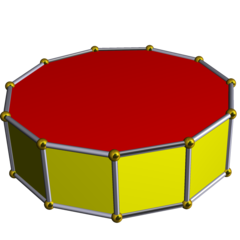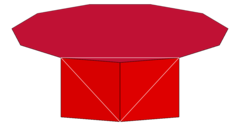Hendecagonal prism
In geometry, the hendecagonal prism is one in an infinite set of convex prisms formed by square sides and two regular polygon caps, in this case two hendecagons. So, it has 2 hendecagons and 11 squares as its faces.
| Uniform hendecagonal prism | |
|---|---|
 | |
| Type | Prismatic uniform polyhedron |
| Elements | F = 13, E = 33 V = 22 (χ = 2) |
| Faces by sides | 11{4}+2{11} |
| Schläfli symbol | t{2,11} or {11}×{} |
| Wythoff symbol | 2 11 | 2 |
| Coxeter diagram | |
| Symmetry group | D11h, [11,2], (*11.2.2), order 44 |
| Rotation group | D11, [11,2]+, (11.2.2), order 22 |
| References | U76(i) |
| Dual | Hendecagonal dipyramid |
| Properties | convex |
 Vertex figure 4.4.11 | |
Related polyhedra
| Family of uniform prisms | |||||||||||
|---|---|---|---|---|---|---|---|---|---|---|---|
| Polyhedron | |||||||||||
| Coxeter | |||||||||||
| Tiling | |||||||||||
| Config. | 2.4.4 | 3.4.4 | 4.4.4 | 5.4.4 | 6.4.4 | 7.4.4 | 8.4.4 | 9.4.4 | 10.4.4 | 11.4.4 | 12.4.4 |
gollark: That's the edu version.
gollark: It's real code on real computers with weird IO.
gollark: This IS real programming.
gollark: I write documentation for the new one!
gollark: https://wiki.computercraft.cc/Http.websocket
External links
This article is issued from Wikipedia. The text is licensed under Creative Commons - Attribution - Sharealike. Additional terms may apply for the media files.